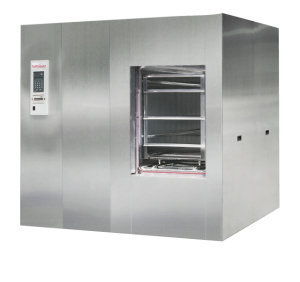by
Lisa Chamoff, Contributing Reporter | October 20, 2014

Tuttnauer 69 Large Capacity Series,
Horizontal Sliding Door- Freestanding
From the August 2014 issue of HealthCare Business News magazine
The methods for sterilizing medical equipment and devices have remained pretty standard for decades — steam sterilization for most surgical devices and ethylene oxide or other chemicals for items that are heat and moisture sensitive. What has advanced in recent years is the technology to track what happens to the devices along the sterilization process, before they’re used on a patient. With cuts in Medicare payments around the corner for hospitals with comparatively high rates of patient infections, there’s more of a focus than ever on making sure equipment is properly sterilized.
In September 2013, STERIS Corporation released its CS-iQ Sterile Processing Workflow Management software, which allows hospital staff to track a device, or a set of devices, electronically capturing data on the sterilization process, as well as chemical and biological indicator test results. Staff can manually enter details, such as verifying that the biological indicators changed color and that the pack looks correctly sterilized upon opening.
“It’s a combination of various sources of data that you can either collect via computer access or [by] manually entering it,” says Dr. Gerald McDonnell, vice president of research and clinical services for STERIS. “It will probably always be a marriage of the two. That mimics essentially what the standards are.”



Ad Statistics
Times Displayed: 172562
Times Visited: 3115 For those who need to move fast and expand clinical capabilities -- and would love new equipment -- the uCT 550 Advance offers a new fully configured 80-slice CT in up to 2 weeks with routine maintenance and parts and Software Upgrades for Life™ included.
CS-iQ can also be used to monitor the washers and sterilizers and STERIS can inform their customers about maintenance issues that arise.
“We can actually tell them that a valve or a temperature indicator might soon need a repair,” McDonnell says.
Cathy Klein, product manager of instrument processing at Midmark, which manufactures smaller autoclaves for doctors’ offices, believes the tracking of instruments back to the patient record will continue to expand in hospitals and filter down to doctor’s offices as more and more procedures are done on an outpatient basis.
“What might have been an overnight procedure in the past, they want to move that to the office now,” Klein says. Most units on the market are self monitoring, with Midmark’s unit offering a printout that includes updates of the time, temperature and pressure every 30 seconds. Klein says the company has extensive digital methods for monitoring in their European product offering. The large steam sterilizers tend to have electronic monitoring.
Market growth
The worldwide sterilization products and services market is expected to grow from $4.7 billion in 2013 to $6.39 billion in 2018, with a 6.34 percent compound annual growth rate, according to a report earlier this year by technology research and advisory firm TechNavio.

